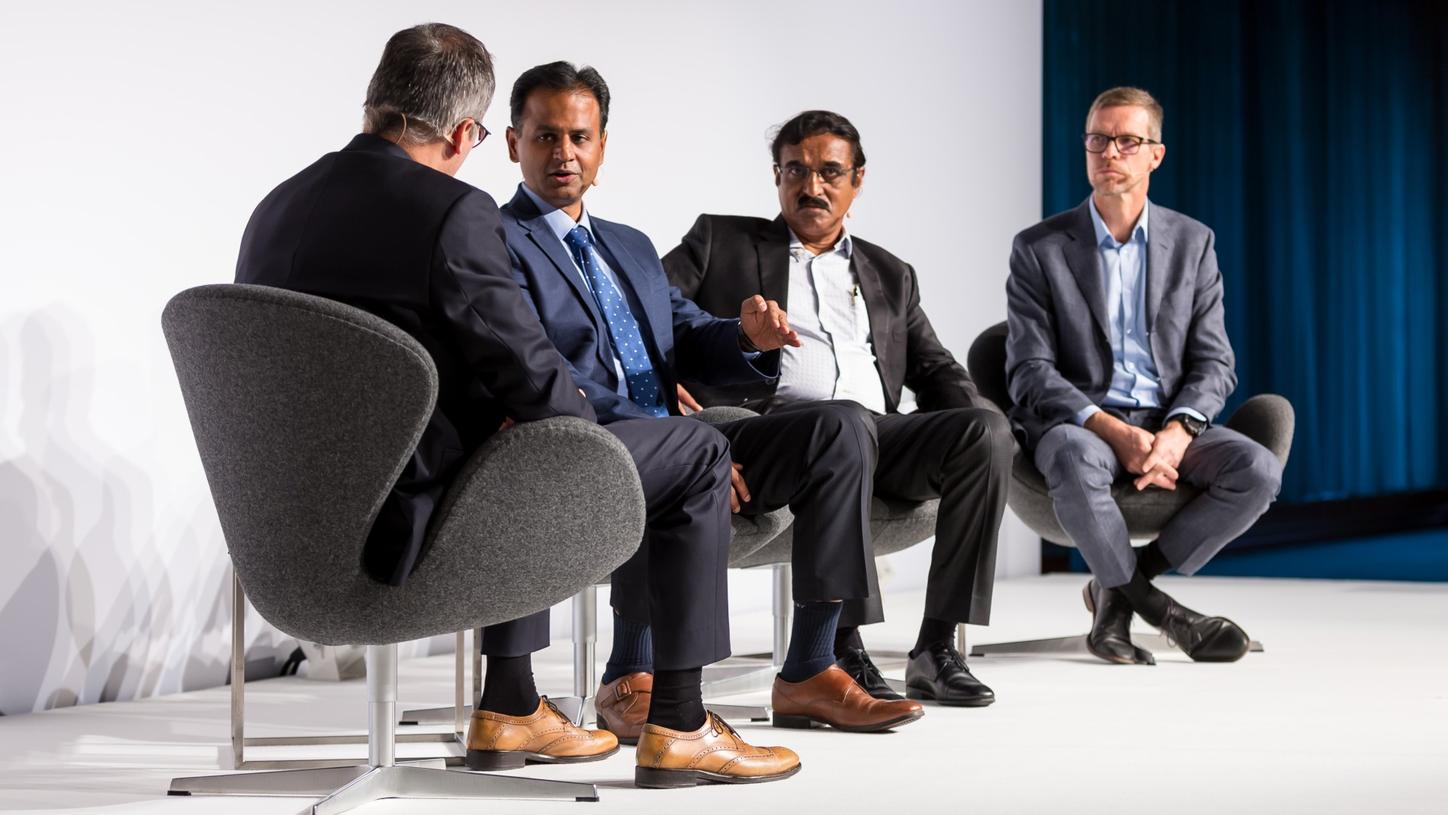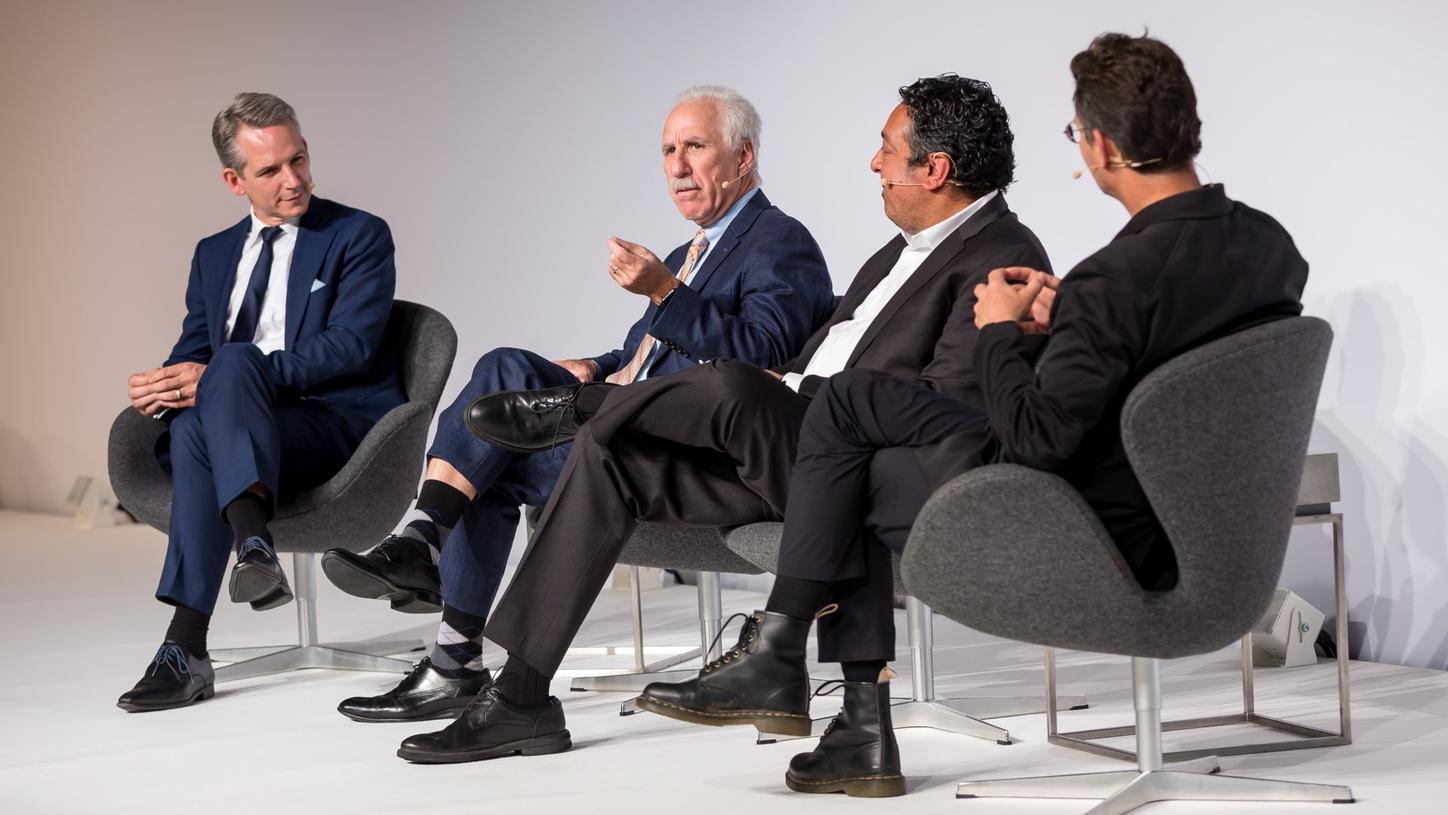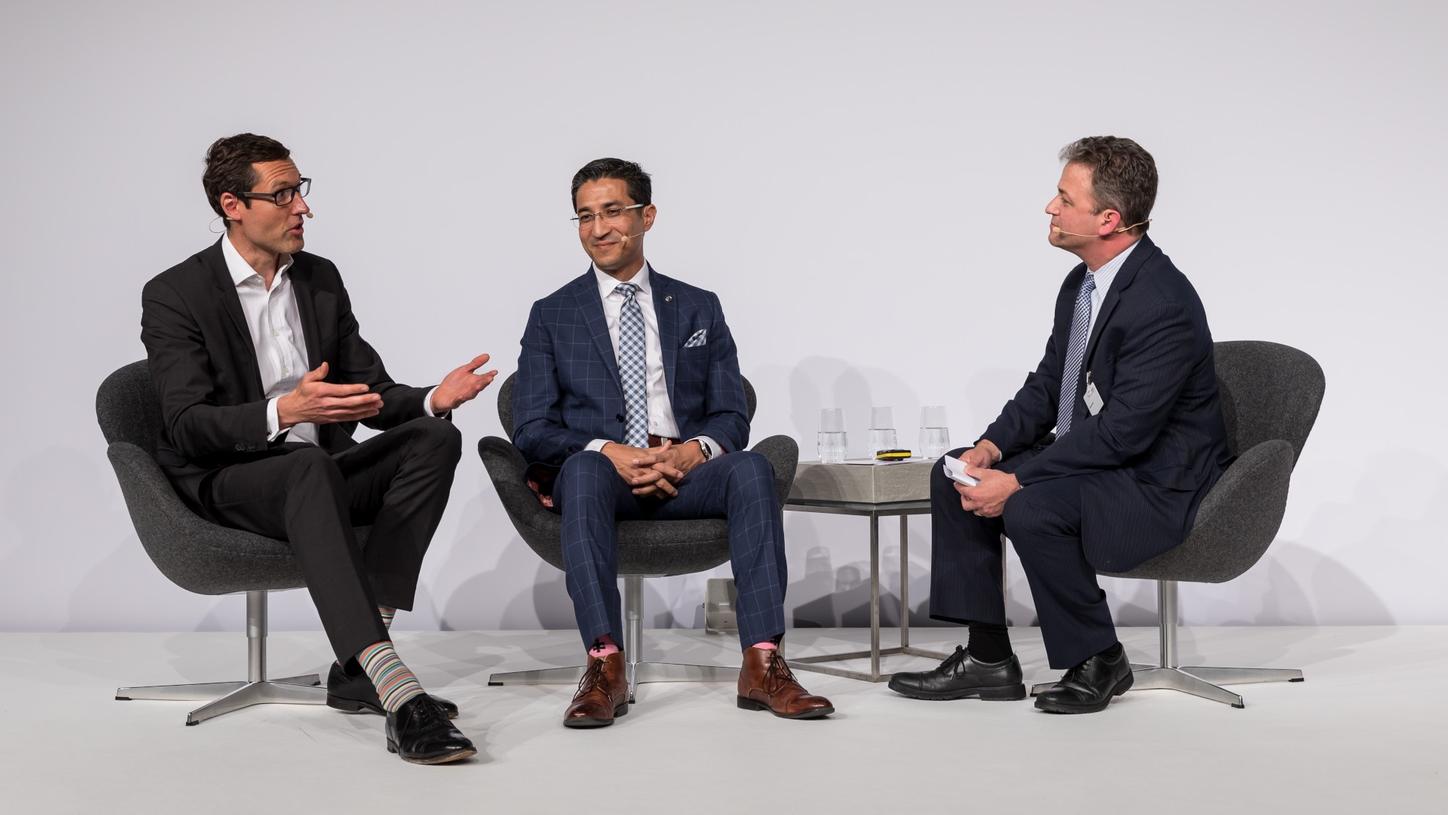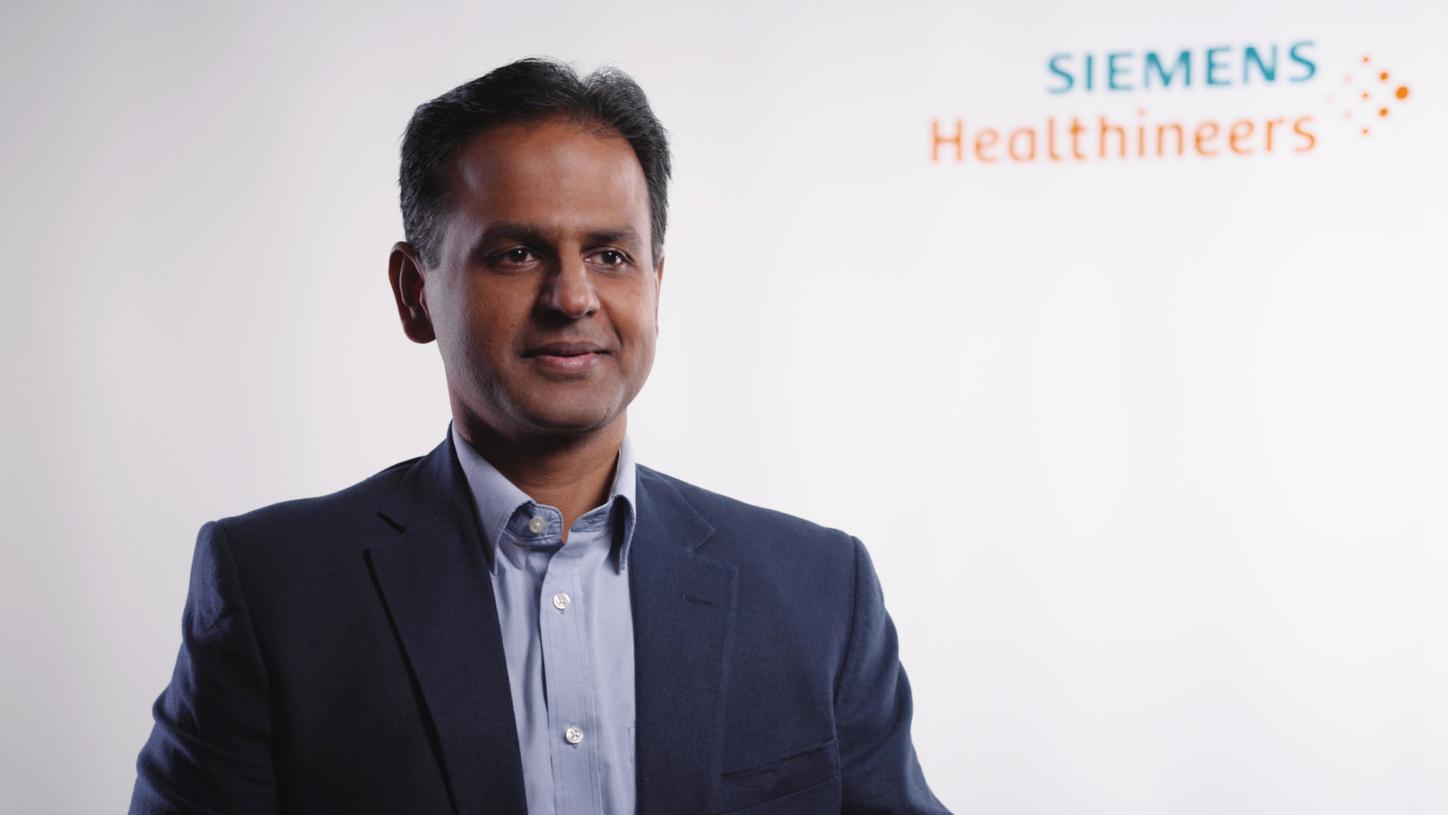Healthcare leaders from across the globe gathered in Amsterdam on October 8th to spend a day sharing and discussing creative solutions to the challenges facing our industry. At the 2019 Siemens Healthineers Executive Summit 200 top executives, decision-makers and thought leaders have been exclusively invited to a full-day series of panels, discussions and networking events.
This year’s Summit focused on a number of central themes: transforming care delivery, expanding precision medicine, scaling innovation, and broader topics of leadership, medical education, and digitalization.
In his opening remarks, Siemens Healthineers CEO Bernd Montag encouraged attendees to participate actively and engage with one another. “Healthcare is a team sport,” said Montag, “and it is essential to learn from your teammates.”
Transforming care delivery: Is better always more expensive?
The day’s opening panel brought together some of the world’s most innovative trailblazers in the area of transforming care delivery. The extraordinary possibilities of high-quality low-cost care were illustrated by Aravind Srinivasan, MD, MBA, Director - Projects at India’s Aravind Eye Care System – and his presentation truly was an eye-opener. The Aravind Eye Care System performs half a million eye surgeries a year at a cost of $90 each, from start to finish – approximately 2% of what such a procedure would cost in U.S. Not only are their prices dramatically lower, their results (for example infection rates and post-surgical complications) are consistently better. Aravind’s approach is, in their own words, an “assembly line” model. Their high-volume approach increases productivity tenfold, and costs are further reduced through innovations like the in-house manufacturing of affordable consumables like suture blades, pharmaceutical products and artificial lenses.
Watch Aravind Srinivasan's full talk here.

B.S. Ajaikumar, MD, Chairman and CEO of Health Care Global (HCG), India’s largest provider of cancer care, then explained how low-cost care is possible not only with elective surgery like cataract procedures but also with complex long-term diseases like cancer. HCG works with an innovative hub-and-spoke model, operating 21 comprehensive cancer care centers across India as well as 20 laboratories, providing services that are affordable, accessible and deliver excellent outcomes. India has a very low cancer detection rate, largely because of challenges many people face related to transportation. Ajaikumar therefore decided, “Let’s bring cancer centers to them.” Today their hub-and-spoke model has approximately 100 oncologists working at their central hub, supporting a wide program of telemedicine, tele-radiology and remote consultation.
A question on the minds of many was whether these models of low-cost, high-volume care delivery were specific to markets like India, where costs are lower and regulation is not always as rigid. This point was addressed by Tarmo Martikainen, CEO of Coxa Hospital for Joint Replacement in Finland. His background is in the automotive industry, and under Martikainen’s leadership Coxa has embraced an operating philosophy not unlike that of the two Indian examples, focusing on high volumes, specialization, a hub-and-spoke model, benchmarking, and rigorous measuring of outcomes. Today, Coxa is the largest joint replacement hospital in the Nordics, performing approximately 5,000 joint replacement surgeries per year, with growth of 15-20% annually and a net promotor score of 95%.
Conversation with Daniel Morissette

Daniel Morissette: What drives a $29 billion healthcare system?
An in-depth conversation with Daniel Morissette, CFO of CommonSpirit Health, provided a glimpse 'behind the scenes’ of one of the largest non-profit healthcare organizations in the U.S. CommonSpirit Health was created earlier this year through the merger of Catholic Health Initiatives (CHI) and Dignity Health and today consists of more than 140 hospitals in 21 states, within reach of one in four Americans.
Daniel Morissette provided a vivid picture of the values and priorities that drive CommonSpirit Health at both an organizational and individual level. “Our merger wasn’t about scale simply for scale’s sake,” he explained. “It was about creating a better, more effective platform to serve people and communities with a higher quality of clinical care at lower cost.”
The priorities of CommonSpirit Health are clearly defined: population health, expanding home-based and virtual care, increasing patient satisfaction, and expanding precision medicine. Morissette pointed out that the CommonSpirit database of medical information is now one of the largest non-government databases in the U.S. and that efforts are underway to leverage this data as part of their Precision Medicine initiative, allowing their full roster of community hospitals to access this information as well as the best academic research.
Morissette closed with an analysis of how the CFO’s role in healthcare organizations is changing. “The CFO still has to make sure that the organization’s financial and operational performance is good. But it’s become a much more strategic role with the CFO setting direction and making strategic decisions about what technologies to invest in and identifying partnerships that help to create value.”
Expanding precision medicine: The new “wonder drug”?
The second Executive Summit panel discussion focused on Expanding precision medicine and asked the provocative question whether this was “a new wonder drug”. Precision medicine has arrived, there is no doubt about that. It is well-established and being implemented primarily in pockets of excellence across much of the healthcare landscape, paying off clinically and financially, with highly individualized, data-driven treatment resulting in lower costs, better outcomes, and less waste.
Yet despite its clear benefits, precision medicine today often remains confined to large academic health organizations. The consensus of the panel was clear: in order to deliver its full value, precision medicine must (i) scale out of academic centers and (ii) must expand to include a broader range of diseases.

Paul Rothman, MD, PhD, Dean of the Medical Faculty & CEO of Johns Hopkins Medicine in the U.S. is a strong advocate of precision medicine. A central element of Rothman’s approach is his belief that many conditions we call “diseases” are actually a collection of different illnesses that we lump together – with the result that we often treat the wrong disease. Paul Rothman believes that a more targeted approach is needed, breaking diseases down into smaller pieces to improve diagnostic accuracy and reduce costs. Under his leadership, Johns Hopkins was an early leader in gathering data and measuring outcomes. Rothman recalls, “We were also one of the first institutions to step back and ask our physicians, ‘What tools, what measurements, do you need to do precision medicine, to guide your therapy decisions?’” Today Johns Hopkins has established sixteen Precision Medicine Centers of Excellence (PMCOEs), and Rothman’s ambitious target is to have 50 such centers up and running within the next five years.
Professor Atul Butte, MD, PhD, is the Zuckerberg Distinguished Professor at the University of California, San Francisco (UCSF) and Inaugural Director of UC’s Baker Computational Health Sciences Institute. Professor Butte is trained in both computer science and medicine, and provided a vivid example of the potential of medical machine-based learning, pointing out that the way we practice medicine is much like the way we play chess. “We make a move, then wait for the disease to make the next move,” explained Prof. Butte. “With a disease like Type 2 diabetes, if we proceed just four steps there are more than 1,500 possible combinations of ‘moves’, with some costing hundreds of times more than others.” For an individual physician, such complexity can be overwhelming. Computers, however, are great at playing chess, and it is precisely this kind of methodical decision-making that machines can do with extraordinary speed and effectiveness. Applied to medicine, machine learning can be extraordinarily effective in helping physicians to identify the right ‘next move’.

Professor John D. Halamka, MD, of Harvard Medical School has a remarkable record of global engagement, helping to transform healthcare organizations in countries throughout the world. But his most compelling example of the impact of precision medicine was one much closer to home, about an experience involving his own wife, Kathy. After she was diagnosed with breast cancer in 2011, her husband was determined to identify the best possible treatment for her, taking into account her age, gender, and ethnicity. Analyzing data from the 17 Harvard-University-affiliated hospitals in the Boston area enabled Professor Halamka to deliver personalized precision medicine to his wife helping to cure her of breast cancer. It also helped their family make more informed decisions. As Professor Halamka noted, “We are all patients. In our case, Big Data really helped us to understand our options. It was so much easier to make rational choices because we had data and examples of other patients like us."
Watch John D. Halamka's whole talk on Expanding precision medicine here.
How to scale and sustain innovation in care delivery
The Executive Summit’s third panel looked at a topic that every healthcare leader has confronted: how to take good ideas and implement them at scale, to make them stick. As moderator Jon Darer said, there is no shortage of innovative new ideas, and everyone wants to be “innovative.” Yet change is hard and often innovative ideas fail to spread, which leads not only to failure in reaching the intended impact for the organization but, if it happens too often, will result in cynicism and disillusioned employees who ultimately lose trust. Then, there are other organizations that consistently succeed in scaling and sustaining innovation, effectively making it part of their DNA. How do they do it?

Professor David Asch, MD, MBA, Executive Director of the Penn Medicine Center for Health Care Innovation and one of the world’s leading behavioral economists, provided fascinating insights into human behavior and its role in healthcare. The mistaken assumption we often make that people behave rationally, and that giving them the right information will lead them to make the right decisions. But this is not always the case, as demonstrated by many non-smoking campaigns.
Looking at both patients and physicians, Asch discussed the science of motivation and the role played by education, rewards (including financial incentives), and simple design changes. As he pointed out, we rarely use defaults effectively in healthcare, pointing as an example to the different results produced by “opt-in” organ donation programs compared to “opt-out”. Another example at the physician level: doctors often have a preference for name-brand drugs, but a small nudge like making generics the default can have huge impact – and result in huge cost savings. As Asch said, “Nudges work in everyday life, and nudges can work in healthcare.”
Are you interested on David Asch's full talk? Watch it here.

Rasu Shrestha, MD, MBA, Executive Vice President and Chief Strategy Officer for Atrium Health and Axel Heitmueller, PhD, Managing Director of Strategy and Commerce at Imperial College Health Partners, offered first-hand insights into the challenges of applying innovation on the front lines of healthcare. Shrestha highlighted what he calls the Three C’s. “You have to have clarity about what innovation really means, the right culture, and a spirit of co-creation.” He also emphasized that innovation often has an essential corresponding step: “You have to learn to forget, to let go of things.” Heitmueller made the important point that in order to create a successful innovative culture the support of the CEO is indispensable. Susan DeVore, CEO of Premier Inc., has a singular record of success in implementing and sustaining innovative reforms across Premier’s alliance of more than 4,000 U.S. hospitals and health systems and shared insights into Premier’s achievements delivering results in areas including technology, data management, group purchasing and resource utilization.

Conversation with Stephen K. Klasko
Stephen K. Klasko: The Disruptor
The day concluded with a lively conversation between Stephen K. Klasko, MD, MBA, President and CEO of Jefferson Health and Thomas Jefferson University, and Ghada Trotabas, Corporate Vice President of Marketing and Commercial Excellence at Siemens Healthineers. Stephen Klasko is a visionary who believes that disruption is necessary to bring about the changes required to shape the healthcare of the future. Why have patients not demanded the same consumer-friendly reforms in healthcare that have been realized in other industries (like travel entertainment and retail)? Why is ‘healthcare with no-address’ the path forward for care delivery? Why do we need an extreme makeover of medical education? Why is there no global system for the qualification and certification of medical professionals? Klasko addressed these questions head-on, with his customary mixture of creativity, insight and passion.
As the leader of both a healthcare network and a university, Klasko has broad scope to put his ideas into practice, commenting, “I like to ask myself, what’s going to be obvious ten years from now, then try to do it today.” While there is no quick fix for the problems confronting us today, Klasko does have some clear ideas about where changes should begin, starting with the way we recruit students to medical schools and train them. “We don’t need medical students to memorize things; we have phones that can do that far better than we can! We need doctors who have compassion, empathy and communication skills. Let robots be robots and people be people.” Global qualification of doctors is another topic high on Klasko’s list of reforms, and he has introduced a program that permits graduating doctors to practice in both the U.S. and in the EU.
Many of the biggest changes in healthcare will be part of what Klasko calls the move toward “healthcare with no address” – a dramatic shift that will bring healthcare closer to patients, in their homes or wherever they may be, driven largely by technological and cultural changes. This not only enhances efficiency and lowers costs, but also serves to make quality healthcare much more accessible. Jefferson is a leader in tele-health and Klasko proudly points out that one of the biggest users of their tele-health service is Philadelphia’s largest homeless shelter.
Takeaways
- Low-cost, high-quality healthcare is possible – in developing and in mature countries. The key is high volumes, increased workforce productivity, optimized clinical operations, (for example by narrow specialization in certain diseases), and the effective use of technology, digitalization and partnerships.
- Daniel Morissette of CommonSpirit Health delivered a powerful message on the importance of implementing a number of transformations in order to deliver better care at lower costs for more people. These include implementing a population health strategy, extending care beyond hospital walls, improving patient experience and expanding precision medicine.
- Precision medicine has the potential to dramatically improve healthcare, contributing to better outcomes and reducing unwarranted variations. And using it effectively is not as onerous, expensive or complicated as many believe; it’s possible to start small, with technology and solutions that allow data to be managed, aggregated and analyzed more effectively. However, precision medicine is far more than just an IT issue. For its efficacy to be fully realized, changes are needed in the way we work and think.
- The success of innovative ideas depends on more than just the quality of the idea itself. It requires the right leadership particularly at the CEO level, organization-wide support, a strong data and analytic function, external support through partnerships with industry and other healthcare systems, and a culture that encourages taking smart risks and learning quickly.
- The success of innovative ideas depends on more than just the quality of the idea itself. It requires the right leadership particularly at the CEO level, a strong data and analytic function, external support through partnerships with industry and other healthcare systems, and a culture that supports taking smart risks and learning quickly.
- Stephen K. Klasko’s most fundamental point was that patients – consumers – will become more active in demanding the kind of healthcare they want and will trigger a transformation of care delivery. This transformation will require disruption. It includes moving away from a ‘one-size-fits-all’ care delivery approach and delivering ‘healthcare with no address’, as well as changes in the way we train and recruit doctors.



